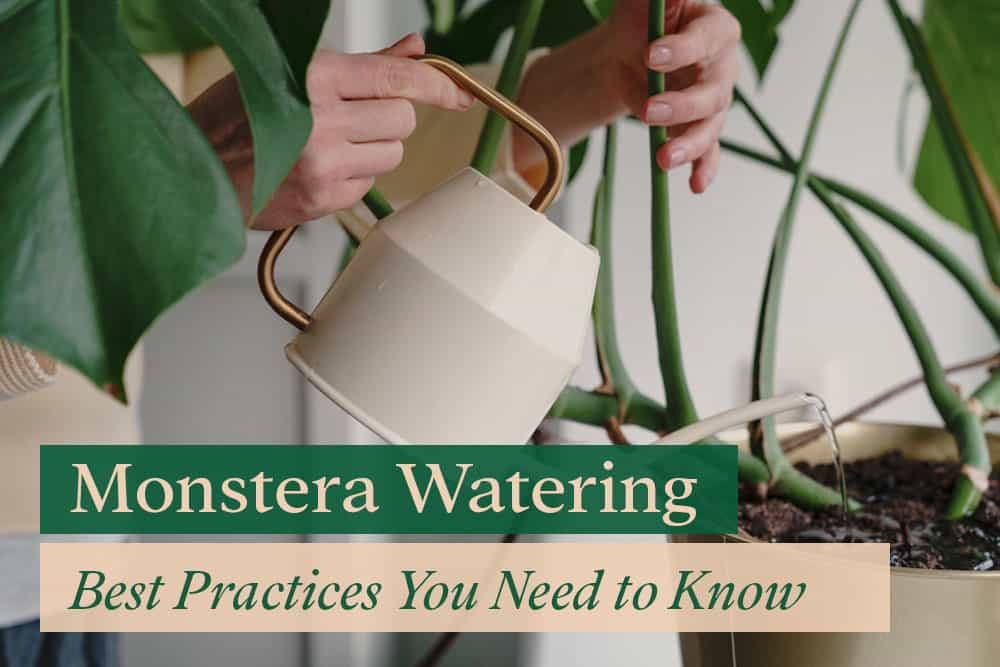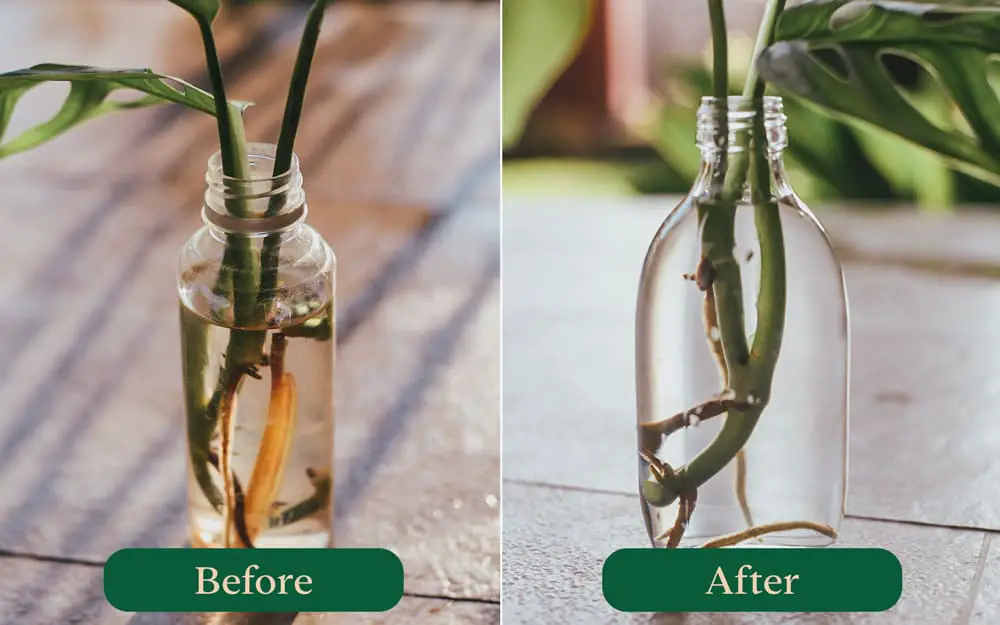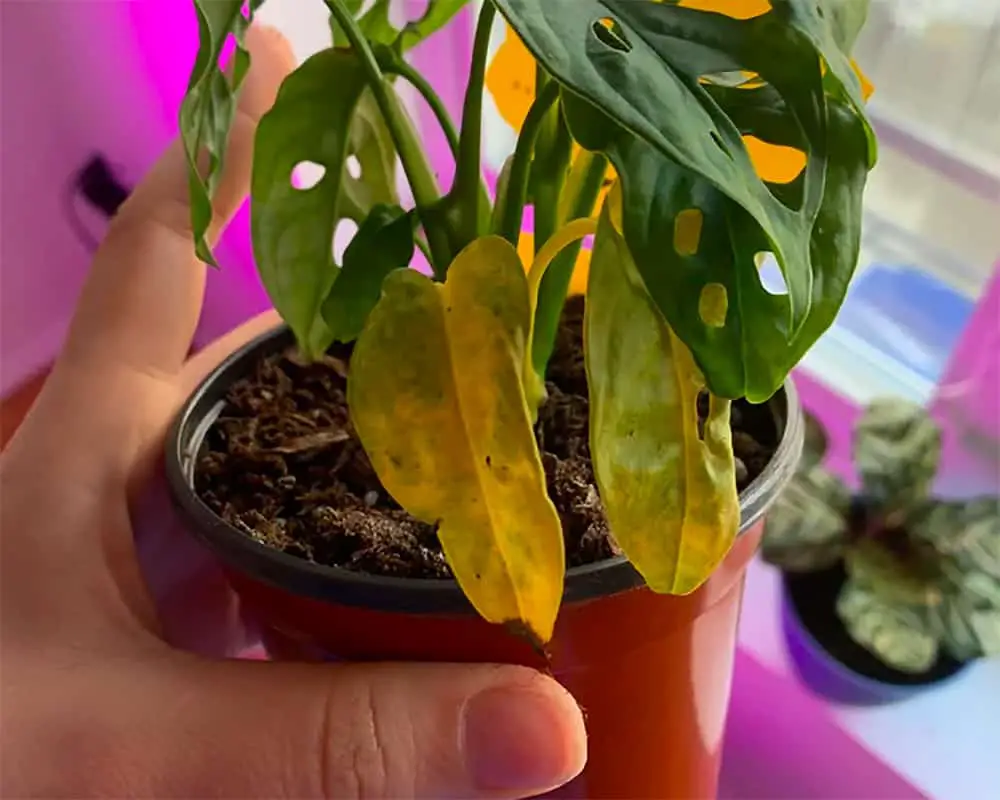
Are you looking for advice on how often and when to water a Monstera plant? How much do they need? Here are some quick tips to get started with care for your Monstera.
Generally, Monstera should be watered with distilled water once a week, or when the top 2 inches of the soil is dry. However, factors such as temperature, humidity, pot type, and soil mix will determine how much and how often it should be watered.
This in-depth article will cover Monstera watering best practices, including:
- Different factors affecting how much watering Monstera needs
- Signs your Monstera is not happy with its watering
- Considerations on how to water Monstera properly
- Common mistakes new plant parents made when watering
Let’s get started!
Different Factors Affecting Monstera Watering Schedule
Let me tell you a secret, I used to overwater my Swiss cheese plant because I followed what most people in the forum told me and watered weekly.
But as it turns out, the mistake was all me because I did not consider other factors such as the Monstera plant was at its dormant stage during a very cold winter and would not require much watering.
So, before you follow my advice to water your Monstera every week, take into consideration the following factors that might adjust how often you should water it:
Seasonality
As I said earlier, Monstera plants’ watering requirement is different during the Summer and Winter.
During the Winter, Monstera plants go dormant as the cold temperature and low humidity are not ideal for photosynthesis. This means the roots no longer need to absorb as much water.
If you overwater the plant during this time, its roots may stay wet for too long, leading to root rot.
In Winter, you should avoid soaking the soil with water. Watering should be done lightly once every 2 or 3 weeks, or only when the soil has been completely dry.
Light
The rate of photosynthesis is best when Monsteras can enjoy bright, indirect sunlight from the south or east-facing window. These Monstera plants will thrive on a weekly watering schedule.

However, I lived in an apartment with very little sunlight coming from a north-facing window, as neighboring buildings would always block the sun.
Under this low light condition, adjust your watering schedule to twice a month to avoid overwatering.
Temperature & Humidity
Both temperature and humidity affect how fast water is lost from Monstera through transpiration.
When the rate of transpiration increases, the roots absorbed more water to maintain their turgidity. So, it is best to reduce the watering intervals to provide the soil with enough water supply to support the plant.
In hotter and more humid climates, you should water Monstera plants every 2 or 3 days. My friends in Singapore and the Philippines do this with their Monsteras, and I can tell they are thriving!
Also Read: Do Watering Plants in the Afternoon Cause Leaves to Burn?
Soil Mixture
I bet you know that to provide the perfect environment for this tropical plant, you have to avoid compacted soil and provide it with aerated and well-draining soil mix.
Here’s the deal from someone who messed up: I used to mix too much perlite and bark into my soil, which meant that my soil drains too quickly and doesn’t retain moisture.
For this reason, I had to water my Monstera almost daily to make sure it stays hydrated. In the end, I had to repot it into a better potting mix that was able to drain water but keep my soil moist.
Pot & Drainage
Pot types and sizes will affect how often you should water your Monstera.
Porous pots such as terracotta or ceramic will allow water to evaporate more quickly, which helps reduce the likelihood of root rot. However, this can lead to having to water your plant more frequently.
Although a larger pot may seem like it would naturally hold more soil volume and retain water moisture longer, it is not a good practice to place your Monstera in an oversized pot.
Ever wondered why? When your Monstera roots are not developed enough to reach the water on the far side of the pot, the wet soil can attract bacteria that can cause the roots to rot.
Propagated Cuttings
Propagated Monstera cuttings planted in the soil will need similar watering practices as mature Monstera.

However, when propagating Monstera cuttings in water, you should change the water every three to five days to avoid fungal infections.
Signs of Improper Watering
As many variables influence how much water a Monstera needs, you need to check signs of under-watering or over-watering, especially on your first few weeks owning one.
Signs of Underwatering
- Droopy and curling leaves – When all the water supply has been lost by transpiration, the leaves lose their turgidity and curls up to prevent further water loss.
- Yellowing leaves with dry brown spots – When plants don’t receive enough water, the leaves show signs of moisture stress and dry out.
- Slow growth – Without sufficient water, photosynthesis will not be optimal, and the plant does not produce enough energy to grow.
Underwatered Monstera is easy to fix; you need to give it plenty of water and soak the soil until the water seeps out of the drainage hole.
Now, set a reminder on your phone so you won’t forget to water your Monstera again!
Also Read: How Long Can Plants Go Without Water?
Signs of Overwatering

- Yellowing leaves – Similar to underwatering, overwatering will show clear signs of moisture stress in your Monstera plant.
- Dark brown spots on the leaves – This is most likely due to root rot developing from overwatering.
- Soil stays soggy after more than 10 days – When poorly-drained soil soaks up water, it stays wet for more extended periods.
- Soil smells bad – The smell is often attributed to bacteria growing anaerobically in waterlogged soil.
Leaving a Monstera plant in overwatered soil will cause root rot, halting growth and eventually killing the plant.
If you are overwatering because the soil is poorly drained, watering less frequently won’t fix it. You need to replace your plant with better-draining soil.
Best Practices on How to Water a Monstera
Now you know that watering a Monstera depends on a few external factors, so how do you make sure you are watering the plant properly?
Here are some considerations you need to be aware of before you water your Monstera:
Check if Soil Need Watering
It is a good practice to check your soil condition occasionally if you have never watered a Monstera before. There are three ways you can check if your Monstera needs watering:
- Finger check: Insert your finger about 2 inches deep into your potting soil. If you feel the soil is still moist, you can wait a few days before watering.
- Stick test: If you are worried about getting your hands dirty, use a thin piece of stick. Insert the stick into the soil, and if it comes up with dirt on it, that means the soil is still damp.
- Soil moisture meter: You can buy a soil meter for a reasonably low price nowadays. Insert the probe about halfway into the pot, and if your reading is above 3, then it means that your plant doesn’t need watering just yet.
Best time to water Monstera
Like most plants, the best time of the day to water your Monstera is in the early morning, between 5:00 am to 09:00 am.

The goal is to make sure Monstera absorbs enough water before the sun becomes too hot and that rate of evaporation from soil or plant transpiration increases.
Which water is best to use
One of the best ways to water a Monstera plant is by using collected rainwater. It contains more oxygen and has a slightly more acidic pH, which encourages micronutrients such as zinc, manganese, copper, and iron that help plants thrive.
Unfortunately, rainwater is not always readily available. So your second best choice is to use distilled or filtered water for your Monstera.
On the contrary, you should always avoid using tap water. Tap water contains concentrated salts in the form of chlorine, fluoride, calcium, and magnesium that accumulate on the soil around the plant’s roots. These salts draw out water from plants instead of letting it absorbed into them.
Also Read: Is It Safe to Use Hot Water for Monstera Plants?
Proper watering technique – Top vs Bottom Watering
There are two types of watering techniques, top watering and bottom watering. When watering your Monstera, you might use both methods alternately for better results.
Top Watering
A more popular watering technique is top watering. This involves pouring water right on the plant’s soil.
Pros:
- Convenience: Top watering procedure will be faster and simpler than a bottom watering process, which would have been more time-consuming and laborious if you had lots of plants.
- Wash off mineral buildup: Eventually, soil in pots will accumulate minerals from fertilizers. Top watering and allowing the water to drain out of the pot is an excellent way to wash these minerals away.
Cons:
- Stain leaves: As you water from the top, you might accidentally get your Monstera leaves wet. If you use hard water, this will leave white residue stains on the leaves.
- Soil may become compacted: Over time, continuous pour from top watering will push down the soil and compact it. This can lead to waterlogged soil if left unchecked.
Bottom Watering
This method of watering involves pouring water into a large saucer and submerge the bottom of the pot in it. This allowed water to be absorbed slowly by the plant through the drainage hole.
Pros:
- Encourage roots growth: As the plant needs to adapt, the roots will grow towards the water source, which is at the bottom of the pot.
- Doesn’t damage the leaves: As you cannot get water to touch your leaves, you don’t need to worry about getting them wet and having stains.
- Hard to overwater your plant unless you keep refilling the saucer with more water.
Cons:
- Encourage mineral buildup: If your Monstera is not top watered at least once a month, there will be no way for accumulated minerals to wash away.
- Tedious process: Especially if you have giant Monstera Deliciosa, it will be a very exhaustive process to move the pot in and out of the saucer.
Common Monstera Watering Mistakes
Now let’s recap on common mistakes new Monstera parents made when watering their plants:
1. Following water requirement recommendations blindly
Yes, Monstera plants indeed need to be watered at least every week in the United States, but this frequency can differ for many countries in different climates.
It is vital to take into other factors, as I had mentioned above. If you’re caring for a Monstera the first time, it is always important to check how quickly your soil dried up before watering again.
2. Having poor-draining soil mix
Compacted and poorly-draining potting soil will slow down water movement through the soil. This can cause the root to be drowned in waterlogged soil.
If your soil does not dry up after 10 days, I strongly recommend you repot your Monstera into fresh soil straight away.
Here, check out my soil mix recipe for my Monstera!
3. Using Tap Water for Watering
Unfortunately, city tap water has been treated with Chlorine to make it safe for drinking. While a minute amount of Chlorine is good for plants, too much of it will kill most of the good bacteria necessary for their growth.
Always use distilled or filtered water instead.
